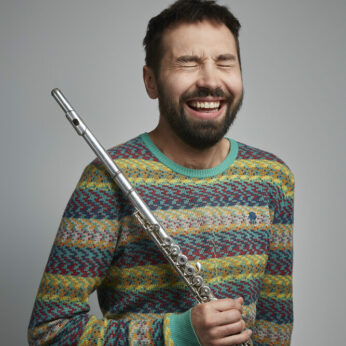Composer: Jean Françaix (b. 1912 - d. 1997)
Performance date: 26/06/2022
Venue: St. Brendan’s Church
Composition Year: 1933
Duration: 00:11:36
Recording Engineer: Simon Cullen, Ergodos
Instrumentation: fl, ob, cl, bn
Instrumentation Category:Wind Quartet
Artists:
Orsino Ensemble (Adam Walker [flute], Emmanuel Laville [oboe], Matt Hunt [clarinet], Alec Frank-Gemmill [horn] Bram van Sambeek [bassoon]) -
[Wind Quintet]

Jean Francaix [1912-1997]
Wind Quartet [1933]
1. Allegro
2. Andante
3. Allegro molto
4. Allegro vivo
Francaix wrote this quartet at the age of 22 for the staff of the Le Mans Conservatoire. He wrote:
As the horn tutor who was there at the time was never quite sure what sound would emerge from his instrument – his fame was as a specialist in the art of playing several notes at the same time – I had decided not to “rouse the volcano”, and had written a quartet without horn which would be less likely to produce disconcerting surprises.
Francaix’s sense of humour is matched by his compositional style. Typically light, full of trills and neat charming melodies, Francaix’s contribution to the wind ensemble repertoire, are works that allow the musicians to display their skills in delicacy of tone, fingering and dynamic control. Only ten minutes long, this unusual work takes us through a myriad of sounds and moods, from the mysterious to the amusing, from the joyful to the melancholy.
The first movement instantly draws in the listener with wonderfully intricate interplay of parts. While the main melody has a simple rhythm and moves smoothly between instruments, it’s gilded with gorgeous ornamentation from supporting parts. It’s succeeded by a perfectly beautiful smooth melody, haunting and intriguing. These two contrasting ideas interplay and the movement ends suddenly with a sudden final note from the bassoon.
The second movement begins in a melancholy mood. The movement is less than two minutes long and as the instruments take their turns to sing out, we’re drawn into one long, continuous line of music. The third movement gives very definite rhythms and with instrumental dialogue, contrasting ideas and quick hopping from one subject to the next, this movement is adventurous and full of character. The final movement opens with all the frantic pacing and frenetic movement of the soundtrack to a silent movie chase scene, complete with wind up car engines and steam trains. The change to a slow and stately interlude pulls the listener back before being startled awake by the final cadence.
Helen Dawson
Copyright © 2024 West Cork Music. All rights reserved.
Designed and developed by Matrix Internet